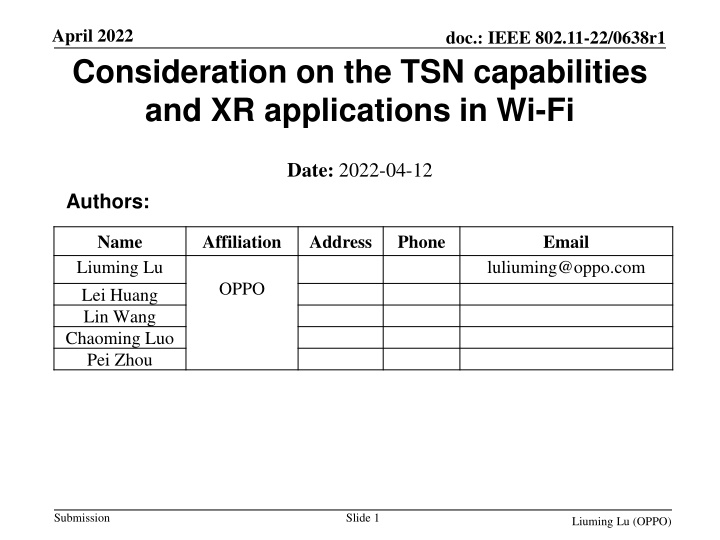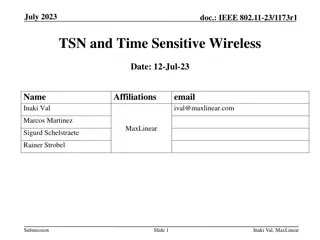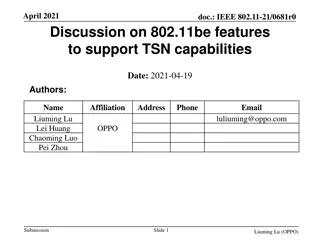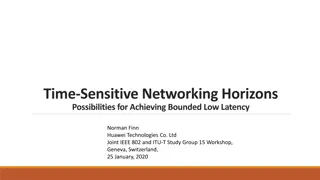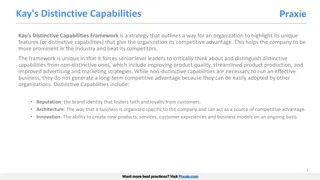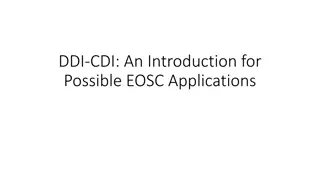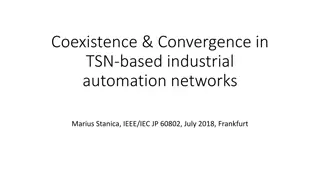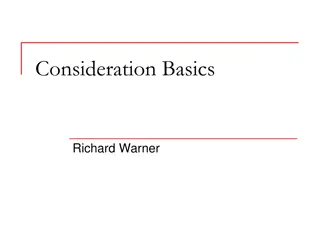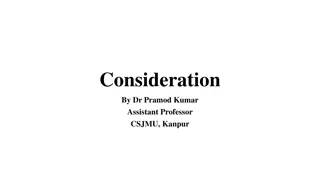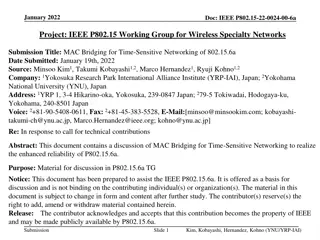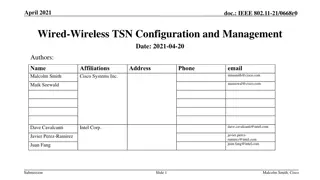Consideration on TSN Capabilities and XR Applications in Wi-Fi
This contribution evaluates XR applications in Wi-Fi, focusing on high throughput, low latency, and reliability. It discusses in-car XR entertainment/navigation as an entry-level TSN application and proposes integrating Wi-Fi technologies like 11be for improved performance. The document highlights the importance of Wi-Fi features for XR Key Performance Indicators (KPIs), emphasizing advancements in multimedia content delivery and real-time traffic optimization. It also addresses challenges such as unpredictable latency due to OBSS interferences in unlicensed operations, stressing the need for controlled environments to maintain efficient transmission of latency-sensitive traffic.
Download Presentation

Please find below an Image/Link to download the presentation.
The content on the website is provided AS IS for your information and personal use only. It may not be sold, licensed, or shared on other websites without obtaining consent from the author.If you encounter any issues during the download, it is possible that the publisher has removed the file from their server.
You are allowed to download the files provided on this website for personal or commercial use, subject to the condition that they are used lawfully. All files are the property of their respective owners.
The content on the website is provided AS IS for your information and personal use only. It may not be sold, licensed, or shared on other websites without obtaining consent from the author.
E N D
Presentation Transcript
April 2022 Consideration on the TSN capabilities and XR applications in Wi-Fi doc.: IEEE 802.11-22/0638r1 Date: 2022-04-12 Authors: Name Liuming Lu Lei Huang Lin Wang Chaoming Luo Pei Zhou Affiliation Address Phone Email luliuming@oppo.com OPPO Submission Slide 1 Liuming Lu (OPPO)
April 2022 doc.: IEEE 802.11-22/0638r1 Introduction This contribution focuses on the XR applications and reviews the Wi-Fi features for XR KPIs (such as high throughput, low latency and high reliability) , and then considers in-car XR entertainment/navigation to be an entry level of TSN applications for Wi-Fi. This contribution also provides the trial results on wireless display connection (such as Miracast), and evaluates the gap to reach the XR KPIs and proposes to incorporate the latest Wi-Fi technologies (such as 11be features for high throughput and low latency) to P2P (such as Wi-Fi Direct) and Miracast. Submission Slide 2 Liuming Lu (OPPO)
April 2022 doc.: IEEE 802.11-22/0638r1 XR Applications XR - an important type of TSN applications for real-time video o VR Gaming o VR and AR in Healthcare o Office collaboration using VR o AR in Interactive and Cognitive Immersive Applications Throughput, low latency(Jitter) and high reliability are KPIs for the requirements of XR applications Data rate Time Synchronizatio n Accuracy Bounded Latency Reliability AR/VR 100 ~ 28,000 Mbps ~1 sec 3 to 10 msec 99.9 to 99.99% Submission Slide 3 Liuming Lu (OPPO)
April 2022 doc.: IEEE 802.11-22/0638r1 Wi-Fi Features for XR KPIs Throughout the growth cycle, Wi-Fi technology advances its capabilities in optimized performance of multimedia content and real-time traffic such as voice, video and graphic-intensive gaming and XR applications. Wi-Fi 5 (802.11ac) Wi-Fi 6 (802.11ax) Wi-Fi 7 (802.11be) 5 GHz spectrum band 20 MHz, 40 MHz and 80 MHz channelization 160 MHz optional LDPC Receive (Rx) Aggregate MAC protocol data unit (A-MPDU) and transmit (Tx) A-MPDU 6 GHz spectrum band 160 MHz channelization Uplink and downlink OFDMA Uplink and downlink MU MIMO Per-link enhancement (1024-QAM ) Target wake time (TWT) Spatial reuse 320MHz channelization enhanced OFDMA : multiple RUs Per-link enhancement (4096-QAM ) Multi-link Operation (TID-TO-LINK mapping) Restricted TWT Triggered UL access optimization Wi-Fi technology makes significant progress on increasing the throughput and reliability, and enhancing the intra-BSS scheduled access, but is still confronted with the risk of unpredictable latency due to the OBSS inferences for unlicensed operation. Submission Slide 4 Liuming Lu (OPPO)
April 2022 doc.: IEEE 802.11-22/0638r1 Controlled Environments are Important OBSS interferences may exist frequently for uncontrolled environments and would affect seriously the scheduled transmission of latency sensitive traffic. For the currently specified enhanced supports for the delivery of latency sensitive traffic, such as AP-Triggered UL access optimization, the medium access protection of restricted TWT, focus on the intra-BSS behaviors. Controlled Environments can avoid or reduce the negative effect caused by OBSS interferences, and lead to the performance improvement of TSN applications. 3GPP support of unlicensed operation as a reference especially in controlled environments, which assumes an environment which contains only devices operating on the unlicensed band and where unexpected interference only sporadically happens. Submission Slide 5 Liuming Lu (OPPO)
April 2022 in-car XR entertainment/navigation as an entry level of TSN applications for Wi-Fi In-car communication provides a relatively controlled environment In-car inference from other radio systems can be avoided by tunning off the systems or adopting different bands for the systems. Car body can block the outside unexpected interference to a certain extent. doc.: IEEE 802.11-22/0638r1 Submission Slide 6 Liuming Lu (OPPO)
April 2022 doc.: IEEE 802.11-22/0638r1 in-car XR entertainment/navigation Wireless display connection Wi-Fi Miracast - a mechanism to discover, pair, connect, and render multimedia content sourced from a Miracast Source at a Miracast Sink. Miracast enables seamless display of multimedia content between Miracast devices. Miracast allows users to wirelessly share multimedia, including high- resolution pictures and high-definition (HD) video content between Wi-Fi devices Miracast Submission Slide 7 Liuming Lu (OPPO)
April 2022 doc.: IEEE 802.11-22/0638r1 End-to-end latency needs to be considered The performance and quality of user experience (QoE) depends not only on 802.11 PHY/MAC but also on the higher layers (Network protocol, Transport protocol etc.) Media An example: Miracast (V2.2) performance depends on Wi-Fi Direct over 11ac and what to be selected for application among TCP/UDP/QUIC. An example - Miracast Architecture with QUIC extensions Submission Slide 8 Liuming Lu (OPPO)
April 2022 doc.: IEEE 802.11-22/0638r1 Miracast Trial - Setup Miracast Specification Version 2.2 (latest version) A WFD R2 Device that supports Wi-Fi Direct over 11ac Miracast Demo App Based on Google AOSP source code for Source & Sink Support TCP & UDP & QUIC mode use lsQuic open source implementation Use commercial-off-the-shelf chipset devices as Source & Sink devices 3 conditions Different throughput from 1Mbps ~ 25 Mbps Different RTT delay from 100ms ~ 700ms Different data loss rate from 0.08% ~ 5.12% Measure dimensions Buff ratio: the buffering time / the total AV streaming time (lower -> better QoE) Rate buff: the buffering times in one casting (the buffering may cause stutter, lower -> better QoE) Join time: the time of the first casting (lower -> better QoE) Rendqual: casting mosaic or distortion or disconnection observed (lower -> better QoE) Throughput QoS parameters Delay (Latency) Reliability (Data loss rate) QoE parameters Rendqual Buff ratio Rate buff Join time Submission Liuming Lu (OPPO)
April 2022 doc.: IEEE 802.11-22/0638r1 Miracast Trial - Throughput test buffratio With the increasing throughput the buff ratio becomes relatively lower, but would be affected a little In higher bandwidth scenarios: 2Mbps to 25Mbps, QUIC's buffratio is close to that of udp and better than tcp. 1 2 5 10 15 20 25 QUIC 26.22% 0.67% UDP 51.90% 0.65% TCP 53.51% 0.70% 0.66% 0.71% 0.80% 0.64% 0.60% 0.66% 0.65% 0.46% 0.67% 0.62% 0.72% 0.67% 0.63% 0.62% 0.68% In the low bandwidth scenario of 1Mbps, QUIC has a lower buffratio than tcp and udp because of its FEC ability. Through mbps TCP UDP QUIC ratebuff With the increasing throughput the rate buff also becomes relatively lower, , but would be affected a little 1.2 1 At higher bandwidths: 2Mbps to 25Mbps, the ratebuff of QUIC is better than TCP and UDP. 0.8 0.6 0.4 0.2 0 In a very low bandwidth environment of 1Mbps, UDP does not need to guarantee that the data must arrive, TCP and QUIC both need to guarantee that the data must arrive so ratebuff TCP>QUIC>UDP. 1mbps 1 0.8 0.9 2mbps 0.7 0.6 0.4 5mbps 10mbps 15mbps 20mbps 25mbps 0.5 0.4 0.5 0.4 0.4 0.3 0.3 0.2 0.1 Through TCP UDP QUIC 0.3 0.3 0.2 0.5 0.2 0.1 TCP UDP QUIC Submission Liuming Lu (OPPO)
April 2022 doc.: IEEE 802.11-22/0638r1 Miracast Trial - RTT delay test (1) buffratio With the increasing RTT delay the buff ratio becomes relatively higher delay has a significant impact on buff ratio and delay less than 100ms is required. The buff ratio of QUIC is closer to that of UDP when the latency is lower, and higher when the latency is higher because UDP is non-reliable, while QUIC and TCP are reliable: UDP > QUIC > TCP 100ms 200ms 300ms 400ms 500ms 600ms 700ms QUIC 0.91% 1.13% 1.33% 1.52% 2.11% 1.99% 2.20% UDP 0.71% 0.79% 0.89% 1.16% 1.28% 1.44% 1.53% TCP 0.62% 0.86% 0.98% 1.19% 1.29% 1.28% 2.48% ratebuff With the increasing RTT delay the rate buff becomes relatively higher, delay has a significant impact on rate buff and rate buff is not zero even in 100ms delay. TCP UDP QUIC 1.1 CDF 1 0.9 0.8 0.7 0.6 0.5 QUIC's rate buff has a smoother CDF as the delay rises, with interval performance 20% lower than TCP and 10% lower than UDP. 0.4 0.3 0.2 0.1 0 0 100 200 300 400 500 600 700 800 delay(ms) Submission Liuming Lu (OPPO)
April 2022 doc.: IEEE 802.11-22/0638r1 Miracast Trial - RTT delay test (2) join time (s) With the increasing RTT delay the join time becomes relatively longer, delay has a significant impact on join time and delay less than 100ms is required for better join time When using TCP or UDP for RTP streaming, the RTSP interactions are still on TCP, so the join time of QUIC is shorter than transporting RTP with TCP or UDP. 8 7 6 5 4 3 2 1 0 100ms 1.2295 1.0661 0.9195 200ms 2.4856 2.3133 1.4913 300ms 3.7007 3.6564 1.7778 400ms 4.5372 3.3317 2.1663 500ms 5.2473 3.9466 2.5155 600ms 6.0791 4.6131 2.9691 700ms 7.5015 5.2219 3.3564 TCP UDP QUIC TCP UDP QUIC Submission Slide 12 Liuming Lu (OPPO)
April 2022 doc.: IEEE 802.11-22/0638r1 Miracast Trial - Data loss test (1) buffratio With the increasing data loss rate the buff ratio becomes greatly higher, data loss rate has a significant impact on buff ratio and data loss rate less than 0.08% is required for better buff ratio The buff ratio of QUIC is closer to that of UDP when the latency is lower, and higher when the latency is higher because UDP is non-reliable, while QUIC and TCP are reliable. 0.08% 0.16% 2.25% 2.36% 2.23% 0.32% 2.53% 2.26% 2.40% 0.64% 2.67% 2.41% 2.44% 1.28% 2.64% 2.57% 2.37% 2.56% 2.74% 2.38% 168.16% 2.46% 5.12% 120% QUIC 0.76% UDP TCP 1.41% 2.12% 217% TCP UDP QUIC With the increasing data loss rate the rate buff becomes greatly higher, data loss rate has a significant impact on rate buff and data loss rate less than 0.08% is required for better rate buff. The rate buff of QUIC has a smoother CDF when the latency rises, and the interval performance is 10% lower than TCP and 5% lower than UDP. Due to the adoption of FEC and NACK, the chance of disconnection is much lower than TCP and UDP in the case of packet loss rate > 5.12%, therefore, the comprehensive performance is better than TCP and UDP. ratebuff TCP UDP QUIC 40 30 20 10 0 0.08% 0.3 0.1 0 0.16% 0.4 0.2 0.4 0.32% 1.2 0.3 0.8 0.64% 1.1 0.2 0.5 loss 1.28% 1.8 1 0.7 2.56% 2.2 1.3 0.9 5.12% 43.7 31 21.2 TCP UDP QUIC Submission Liuming Lu (OPPO)
April 2022 doc.: IEEE 802.11-22/0638r1 Miracast Trial - Data loss test (2) For UDP data loss rate has a significant impact on Rendqual TCP and QUIC are reliable without mosaic or distortion observed. Mosaic or distortion observation rises gradually with the packet loss rate for UDP Rendqual TCP UDP QUIC 1 0.9 0.8 0.7 0.6 CDF 0.5 0.4 0.3 0.2 0.1 0 0.00% 1.00% 2.00% 3.00% 4.00% 5.00% loss Submission Slide 14 Liuming Lu (OPPO)
April 2022 doc.: IEEE 802.11-22/0638r1 Throughput and End-to-end latency needs to be improved Current throughput and end to end latency with high reliability of Wireless display connection (especially for Miracast) needs to be further improved for future XR applications incorporate the latest Wi-Fi technologies (especially low latency with high reliability) to P2P(such as Wi-Fi Direct) and Miracast 802.11be Features to support the delivery of latency sensitive traffic can narrow the gap. 802.11be Features for low latency Benefits Multi-link Operation (including TID-TO-LINK Mapping) 1. Increase the throughput 2. Provide multiple paths for traffic delivery 3. Convenient for flexible Traffic scheduling 4. QoS traffic prioritization preferred link for latency-sensitive traffic Low latency Restricted TWT (Target Wake Time ) 1. Enhance medium access protection 2. Resource reservation 3. Convenient for flexible Traffic scheduling High Reliability Triggered UL access optimization 1. Trigger based on QoS requirements 2. Convenient for flexible traffic scheduling Submission Slide 15 Liuming Lu (OPPO)
April 2022 doc.: IEEE 802.11-22/0638r1 Summary This contribution also provides Miracast trial, and evaluates the gap to reach the XR KPIs and proposes to incorporate the latest Wi-Fi technologies (such as 11be features for low latency) to P2P (such as Wi-Fi Direct) and Miracast. Submission Slide 16 Liuming Lu (OPPO)
April 2022 doc.: IEEE 802.11-22/0638r1 Reference [1] IEEE 802.11be Draft 1.5 [2] Miracast Specification Version 2.2 [3] 11-22-0080-02-0000-wi-fi-and-tsn-enabling-deterministic- wireless-for-time-sensitive-applications [4] RP-210854, Enhanced Industrial Internet of Things (IoT) and ultra-reliable and low latency communication (URLLC) support for NR Submission Slide 17 Liuming Lu (OPPO)
